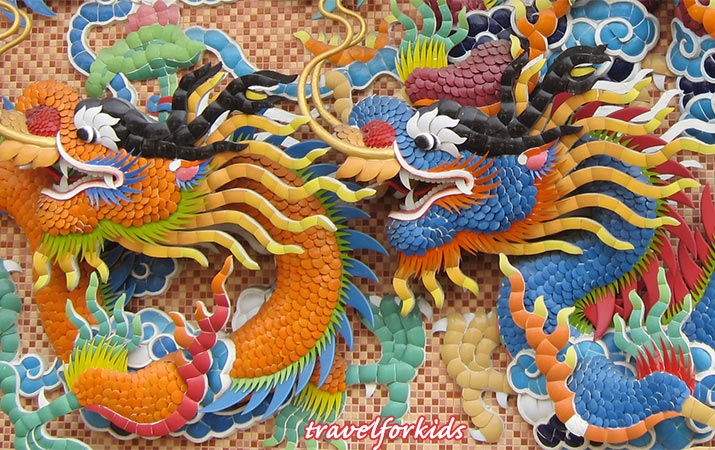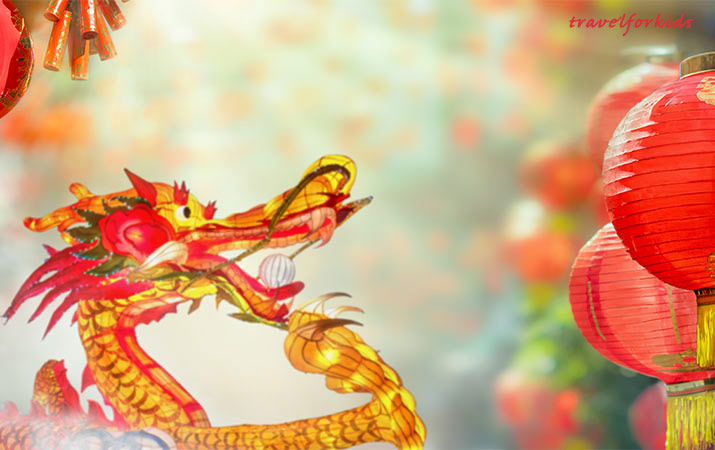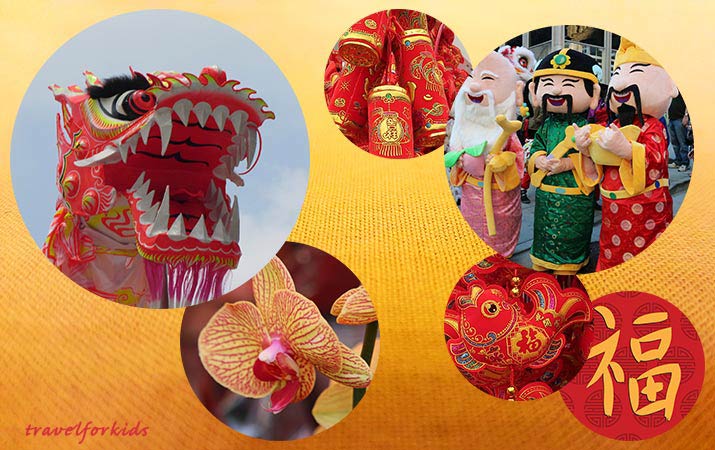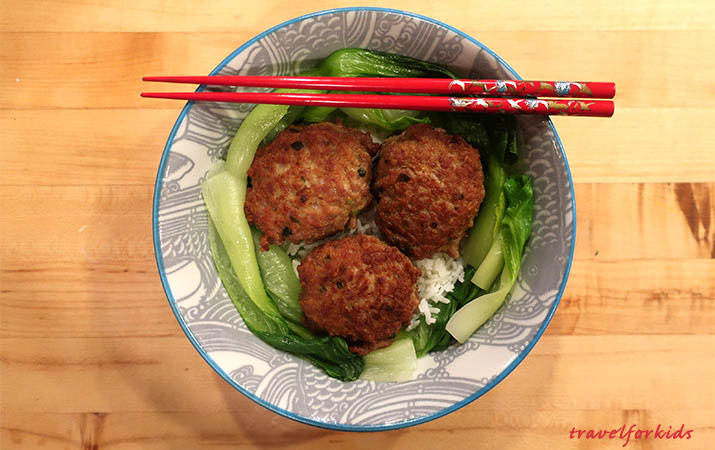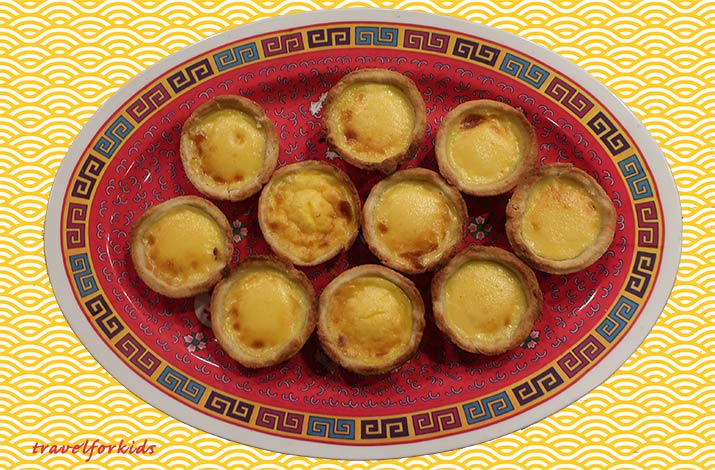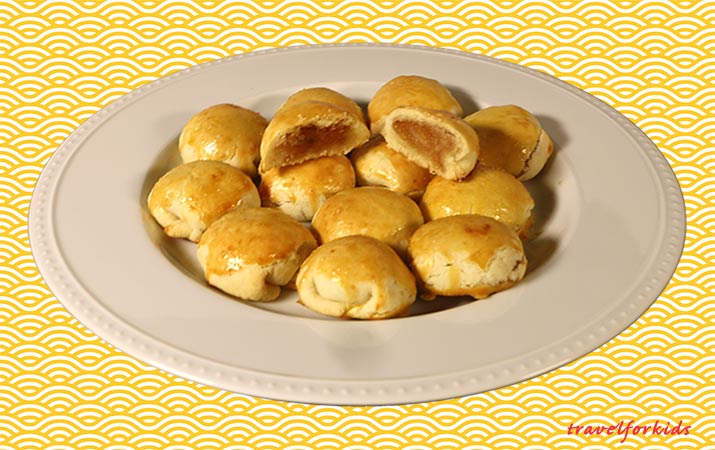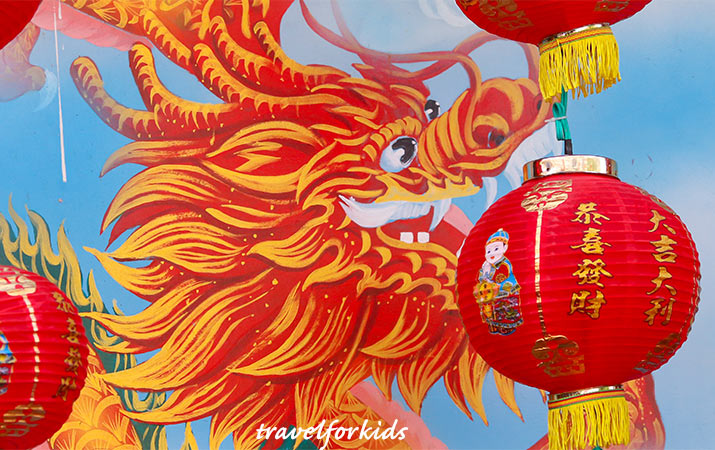Lunar New Year is coming up on February 10, celebrated on days of the new moon (Spring and Lantern Festivals) in the lunar calendar.
New Year 2024 is the Year of the Dragon.
Families and friends get together, cook and share special foods (especially dumplings and sticky rice cakes), wear new clothes, decorate houses with symbols of luck and prosperity.
Lunar New Year, also called Chinese New Year, is celebrated in Asian countries, from Tibet to Vietnam, and in many cities around the world, with parades, music and dance, performances, lion and dragon dances.
New Year Legends
Origins of Chinese New Year is narrated in the legend of the Nian monster. There are many versions of this story, it could be it’s a little boy, beggar, old monk, other heroes, who confront the monster.
Each year, the Nian monster would come to earth and destroy whole villages. The old monk cleverly gave Nian some sticky rice cakes, the monster’s mouth stuck together so he couldn’t eat people. Then monk told the villagers that Nian doesn’t like loud noises or the color red, so they lit firecrackers, which scared away Nian, and the villagers were saved.
The Lantern Festival, ending the holiday, is celebrated with red lanterns and firecrackers.
In the mists of time, the Jade Emperor in Heaven was angry with people and tried to destroy the earth with fire. Instead the Jade Emperor’s daughter came to earth, and told everyone to light red lanterns and set off lots of exploding firecrackers. The Jade Emperor was fooled into thinking earth had burned up, so everyone was saved.
Parades, Lion and Dragon Dances
We are lucky to live in the San Franciso Bay Area, one of largest and oldest Chinese communities in the United States.
Here’s the Spring Festival Parade, with boys and girls drumming, dancing with scarves, Fu, Lu and Shou, three gods of prosperity, good fortune and longevity, drumming and martial arts, lion dances with yellow, red, black and white lions, even balancing on high poles, and red dragon dance, swooping and chasing a ball (which represents “pearl of wisdom” or sun for a good harvest).
Lantern Festival Parade is the finale of the New Year celebration. A spectacular nighttime parade through the streets of downtown San Francisco with huge figures zodiac animal of the year and lucky gods, marching bands, acrobats, lion dances and a huge dragon, carried by 100 people.
See how the Lunar New Year is celebrated in Bangkok. Yaowat Road is turned into a pedestrian mall of the first day of the festival. The street is lined with stalls, where vendors sell red clothes, red fruits such as pomegranates and strawberries (good luck for the coming year). Martial arts groups perform lion and dragon dances, stopping at merchants to bring luck and prosperity in the coming year.
Lucky New Year Symbols
The Lunar New Year is a time of new beginnings, and wishes for good fortune, prosperity, long life and abundance in the coming year.
Decorations, food, flowers, performances have special symbols and significance.
Read our separate blog post Lucky Symbols of Chinese New Year – to find out meaning of Three Star Gods Fu, Lu and Shou, fish, bamboo, mandarin oranges, firecrackers, lions, dragons, and more.
Children’s Books
Here’s our favorite books to read about the Lunar New Year:
- Celebrate Chinese New Year by Carolyn Otto. Travel around the world to see celebrations of Chinese New Year – family feasts in China and fireworks in Taiwan on New Year’s Eve, parade of lantern lights in Japan, ice sculpture in Mongolia, parades and dragon dances in London, Vancouver and San Francisco. Gung Hay Fat Choy! (Picture book)
- Ruby’s Chinese New Yearby Vickie Lee, Joey Chou.Little Ruby is going to Grandmother’s house to bring her a special card for the New Year. On the way she meets Cat, Rat and Ox who is carrying sweet treats, continuing along, Tiger and Rabbit come too, Dragon and Snake bring lanterns, Goat has flowers, Rooster and Monkey fish for the feast. Fun story with all the animals of the zodiac. (Picture book)
- Bringing in the New Year by Grace Lin. Families greet the Chinese New Year – sweep away the old year, cook special dishes, get a haircut, put on a new dress, enjoy a New Year’s feast, and carry lanterns to light the way. (Picture book)
- Dragon Dance by Joan Holub and Benrei Huang. Charming “lift the flap” book about Chinese New Year. Little kids can lift the flap to see house decorations “Good Luck and Good Fortune,” a feast with very long noodles, lion dancers, and last of all, the dragon. (Picture book)
- My First Chinese New Year by Karen Katz – Delightful introduction to Chinese New Year for younger kids. A little girl sweeps away bad luck, gets a new red dress, helps make special foods with Grandma, shares a feast with all the relatives, and watches the New Year parade. Adorable illustrations. (Picture book)
- Gordon & Li Li Celebrate Chinese New Year by Michelle Wong McSween, Jeannie Chen – Celebrate Chinese New Year in English and Chinese with cousins Gordon and Li Li from China – traditions, the color red, home decorations, lucky foods, zodiac animals, special greetings Phonetic Mandarin pronunciation is very helpful. Gong xi cai fai – Wishing you prosperity! (Board book).
- Tet Together by Alice D. Trinh, Jade Le – Tet is name for Lunar New Year, celebrated in Vietnam. The holiday has its own traditions, each year has zodiac animals (some are different – cat instead of rabbit, buffalo instead of ox), red and yellow decorations symbolize good fortune and happiness, lucky plants and flowers are apricot blossoms and kumquat trees, sticky rice cakes, chicken and candied fruits are special foods. (Picture book)
- A Sweet New Year for Ren by Michelle Sterling and Dung Ho – Every year Ren’s family gathers together to prepare special dishes for the Lunar New Year. Ren helps make pineapple cakes – buttery golden dough filled with pineapple jam.
- This delightful book inspired us to bake pineapple cakes! See recipe below.
- Lunar Tale by Stella Hong – Go on a Lunar New Year adventure with twelve magical zodiac friends – rat ox, tiger, rabbit, snake, horse, ram, monkey, rooster, pig – through tea gardens, bamboo groves to the sparkling city, with a temple honoring the ancestors, big family reunion, ending with dragon dance in Chinatown. Delightfully illustrated! (Board book)
Fun Food
“Your future looks delicious.”
Every year we try out new recipes to celebrate Lunar New Year.
Here’s Lion’s Head Meatballs, a specialty of Shanghai, and for dessert, egg custard tarts.
Lion’s Head Meatballs
1 pound ground pork
1 tablespoon sugar
1 teaspoon salt
1 tablespoon shaoxing cooking wine, mirin, or sake
2 tablespoons soy sauce
1 tablespoon sesame oil
1 green onion, chopped finely
1 teaspoon minced ginger
2 cloves garlic minced (up to 3)
2 eggs, beaten
1/4 cornstarch
1 pound bok choy, stems trimmed but otherwise intact
Vegetable oil for cooking meatballs
Combine ground pork, sugar, salt, Shaoxing (or mirin, sake), soy sauce, sesame oil, green onion, ginger, garlic.
Add cornstarch, mix well. Then add eggs until mixture is well blended.
Steam the bok choy.
In a pot with steamer, or a skillet with lid (add a little water), steam the bok choy for about 2 – 5 minutes (depending on size of boy choy) until cooked, but not limp. Keep warm.
Cook rice.
Cook Jasmine rice to go with meatballs and bok choy.
Cook meatballs.
Use ice cream scoop to make meatballs. Flatten into patties.
Pour some oil into large frying pan. Cook meatballs on medium low heat, about 3 minutes until browned, flip over to other side, cook 3 minutes more, than cook until meatballs are done.
In large bowl, put in large scoop of rice, put in meatballs, surround with boy choy to make a “green mane” around the meatballs.
Egg Custard Tarts
Pastry Dough
2 cups all purpose flour
½ cup unsalted butter, cold and cubed into half inch pieces
2 tbsp powdered sugar
¼ tsp salt
¼ cup ice water
Custard Filling
4 eggs, beaten
¾ cup hot water
1/3 cup heavy cream
¼ cup sugar
½ tsp vanilla extract
In food processor, add flour, cubed butter, powdered sugar and salt. Pulse mix on and off for one minute, until the consistency of the flour mixture turns into small crumbs.
Drizzle ice water into the mixture. Close the lid and continue to pulse mix on and off for another 1 minute. Squeeze the crumbs together with your hands, making ball of dough.
Flatten the dough, on lightly floured surface, roll dough ¼ inch thick.
Use 3 ½ inch cookie cutter to cut out 12 rounds.
Press dough into non-stick 12 cup muffin tin. Refrigerate pan until custard filling is ready.
Heat oven to 450 degrees.
In small bowl, whisk beaten eggs, hot water, heavy cream, sugar and vanilla extract until smooth and sugar is dissolved. Optional, strain filling through fine mesh strainer to remove any lumps.
Pour custard into dough shells in muffin tin, up to ¾ full.
Bake 16 – 18 minutes, until golden brown and custard is set. Allow tarts to cool for 5 – 10 minutes in pan, then remove, and serve warm.
Store completely cooled tarts into airtight container, and store for up to 3 days in the refrigerator.
Tip: To make mini-egg custard tarts, use 2 inch cookie cutter for the dough rounds, and 24 cup mini-muffin tin. Cook 12 – 15 minutes.
Recipe adapted from Ahead of Thyme, by Sam Hu.
Pineapple Cakes
Pineapple Cakes (also called pineapple tarts, pineapple rolls) are very popular at the Lunar New Year in Taiwan, Singapore, Malaysia and Indonesia.
Pineapple jam
1 lb 2 oz frozen pineapple chunks or canned pineapple
2 1/2 tbsp sugar
2 tbsp dark brown sugar
¼ tsp salt
¼ tsp vanilla extract
1 cinnamon stick
1 star anise (optional)
2 cloves
Dough
10 tbsp unsalted butter, room temperature
2 ½ tbsp sugar
½ tsp salt
4 large egg yolks
¼ tsp vanilla extract
1 ½ cups all purpose flour, plus more for dusting
5 tbsp, plus 1 tsp cornstarch
Make the pineapple jam:
Thaw frozen pineapple, drain canned pineapple. Put pineapple food processor or blender, process on low speed to make coarse, slushy puree, some small chunks should remain.
To a medium saucepan, add pineapple, sugar, brown sugar, salt, vanilla, cinnamon, star anise and cloves. Turn the heat to medium and simmer, stirring frequently and scraping the bottom of the pan, until jam is reduced in volume by half, turns amber in color, and no liquid remains – about 45 minutes.
Turn off the heat, remove and discard whole spices, set jam aside to cool to room temperature. There should be about 1 cup of jam.
Using teaspoon-sized measuring spoon, scoop jam in 28 portions. Roll in hands to form ¾ inch balls. Arrange balls in single layer on baking sheet, cover tightly with plastic wrap. Refrigerate for at least 2 hours, or up to 1 week.
Meanwhile, make the dough:
Put butter, sugar and salt into stand mixer with paddle attachment. Turn mixer to high speed, mix until pale and fluffy, about 2 minutes.
Add 2 egg yolks, 1 ½ tbsp cold water, vanilla, mix to incorporate. Turn speed to low, add flour and cornstarch, mix until no streaks of flour remain, about 15 – 20 seconds, until dough comes together. (If dough looks at feels crumbly at this point, add bit more water, tsp at a time, until dough comes together.)
Gather dough into ball, wrap tightly in plastic wrap, refrigerate at least 2 hours, up to 24 hours. (Dough may be stored in freezer up to 2 weeks, defrost overnight in fridge.)
To assemble tarts, preheat oven to 350 degrees. Line large baking sheet with parchment paper.
Remove dough from fridge, let soften for 10 minutes. Unwrap pineapple jam balls, unwrap and arrange, ready to use.
When dough is malleable, divide into 2 ½ teaspoon balls. Using hands, roll dough into smooth ball, flatten between palms to form 3 ½ inch disk. (Flour hands if dough is sticky.) Place pineapple jam ball in center of dough, and fold up sides. Roll filled dough in hands to make smooth ball, place on baking sheet, arrange cakes at least 1 inch apart.
Beat remaining 2 egg yolks with 1 teaspoon cold water, use pastry brush to brush yolk evenly over the cake.
Bake until golden, rotating baking pan halfway through, 16 – 20 minutes. Remove from oven and set aside to cool completely on baking sheet.
Store in airtight container at room temperature for up to 1 week.
Adapted from Saveur.com, “Pineapple Tarts” by Yi Jun Loh.

